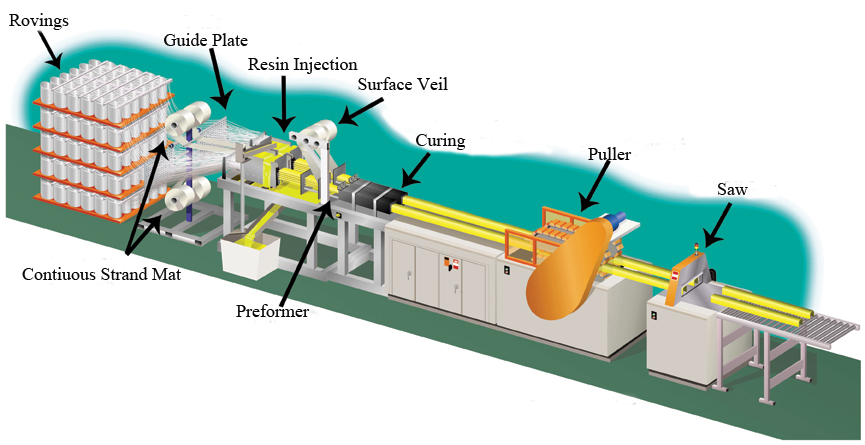Process
Pultrsuion profiles are manufactured by put the reinforced materials impregnated resin adhesive, such as fiber roving, continuous strand mat or other fabrics, under the pull force, through a group of preformer into a die, and then cure by heating, continue to produce FPR profiles with unlimited length.
Fiberglass Profiles is a popular option because of its cost-effectiveness, energy efficiency, affordability, eco-friendliness, and minimal waste generation. It is the best method for situations that require large quantities, rapid production, and continuous manufacturing.
The general profile pultrusion process and equipment shown as following picture.

Reinforcement Material
The glass fiber is the most common used reinforcement material in composites. It is made from melted glass with an almost circular cross-section. This textile glass is made out of high quality E-glass and, for special applications, also out of R-glass and C-glass. The relatively high strength and modulus values are a consequence of the strong bonds between silicon and oxygen in a spatial network. Due to the amorphous structure, glass fibres are, as opposed to carbon or aramid fibers, isotropic.
Fine fibers combined into certain weight formed fiber roving applied in pultrusion for longitude (length direction) reinfocement. The mats formed by the same fiber applied for latitude (transvers direction) reinforcement.
Beides the glass fiber, carbon fiber, aramid fiber and others are also used in pultrusion for some special purpose.
Resin
The unsaturated polyester resins are among the most commonly used resins in composite materials. UP resins are a colourless to slightly yellow solution of unsaturated polyester in a reactive solvent, usually styrene. At room temperature or by supply of heat, they are cured, whereby a heat reaction is released. There are ISO and Ortho polyester resin usually used in pultrusion, ISO supplies higher performance and expensivelly.
The Hicoma pultrusion profile applies ISO polester resin unless otherwise indicated.
The vinyleaster resin acheives composites higher chemical resistance, profile usded in sea water for example.
The epoxy resin acheives composites higher stength, chemical resistance and excellence electical performance, but expansive. It is widely used in eletrical engineering filed.



 angela.liu@nhcfrp.com
angela.liu@nhcfrp.com
